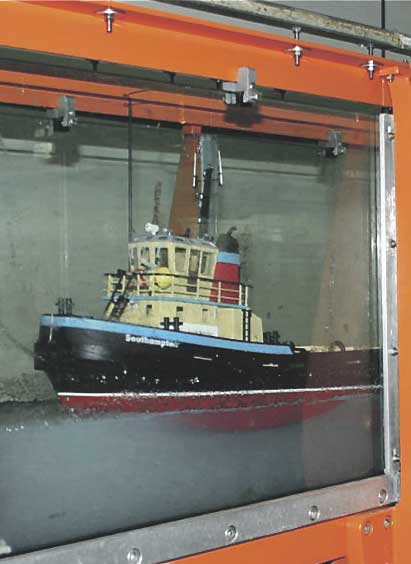Navigation prize
Every user knows gps devices generally do not perform too well in city centres (where you need them most).
High rise buildings block the navigation signals. Peter Buist (MSc aerospace engineering) wants to upgrade navigation devices by adding magnetic and gyro sensor inputs – just like what happens in spacecraft. The idea won him the European Satellite Navigation Competition (ESNC 2011). He can now proceed to build a prototype with sponsoring companies Logica and Lencon.
Double magnetic
Weak and strong magnetism can coexist in subsequent atomic layers of lattices. So said TU Delft professor, Ekkes Brück, and co-researchers from Nijmegen, last week in the journal Advanced Energy Materials. By combing both types of magnetism, researchers can amplify the magnetocaloric effect (heating by magnetising) and manipulate the working temperature. The materials are ready for application in efficient cooling or power generation. AEM, Vol.1, Issue 6, p. 1215-1219.
Breathing mask
Dr Johan Molenbroek of the department of applied ergonomics and design (Industrial Design Engineering) has recently been awarded a project subsidy by the Princess Beatrix Fund for further developing a breathing mask for children. The idea for the project came from the Michel Holper’s Bachelor’s thesis project in 2008. One of the components of new project involves creating 3D scans of children’s heads, so that a better fitting breathing mask can be developed for children in the two to six year age range. At present, children are often fitted with masks designed for adults.
Few people may have noticed, but since last Sunday railway traffic has changed some. Just as it does every year in December, NS, the national rail service company, published the new timetable for the coming year. This year’s changes – slightly more trains running between Groningen and Leeuwarden, for instance, and more high-speed Fyra trains – fit on a single sheet of paper.
And while these changes may seem simple to incorporate into the present schedule, according to train traffic researcher, Dr Francesco Corman (faculty of Civil Engineering & Geosciences), it will take NS and ProRail (which manages the railway infrastructure) months to work it all out. “They’re probably already working on the schedule for 2012,” he says.
But what takes months for NS and ProRail to do, Dr Corman can do in minutes or even seconds. With his mathematical model, he can run through all possible combinations of desired train movements in regions of the country and decide which schedule is most efficient. Last week Dr Corman defended his dissertation, entitled ‘Real-time railway traffic management: dispatching in complex, large and busy railway networks’.
The model can come in handy when problems occur on the track, such as when switches become frozen, which happened on a large scale a few weeks ago. Another problem ProRail had to cope with recently was a fire in the traffic control centre in Utrecht, resulting in train delays occurring all across the country. “My model makes it is possible to minimize the propagation of delays caused by these problems,” Dr Corman adds.
One of the main sources of a railway system’s unreliability is the fact that trains have limited possibilities for overtaking along lines; rather, they must follow each other’s path sequentially, until an overtaking or passing track is reached. Because of this, interaction delays propagate very quickly. A certain amount of slack is included in the timetable to absorb slight delays, but if a train is seriously delayed the domino effect kicks in.
By performing online adjustments during operations however, it becomes possible to minimize disturbances. “The trick is to think wisely about the chain of events you want to set in motion,” says Dr Corman, whose model can help calculate millions of different options.
“My model could help the guys in the traffic control centres. When they choose a solution the model has offered, they’ll know that by doing so they will not be creating troubles for their colleagues in another part of the country.”
Of course there are some assumptions behind this model: one is that ProRail knows the location and speed of every train at every second. “At the moment it doesn’t,” Dr Corman notes. “ProRail only knows
between which two traffic signals along the track the trains are located. And it doesn’t know anything about the speed. The NS knows these things, but at the moment they’re not sharing this information, and even if they would, ProRail isn’t equipped to handle all these data.”
According to Dr Corman, ProRail is not very keen on investing in such operations at the moment: “It takes some time before you would see the results of these investments. ProRail has had so many problems lately that they’re now focused on ameliorations in the short term.”
Still, Dr Corman believes ProRail deserves to be cut some slack. “It’s true that the infrastructure is outdated,” he explains, “but that is if you compare it with other infrastructure systems, like the air traffic system for instance. But compared with other countries in Europe, the railway system in Holland is extremely dense and well organized.”


Gelatin
Waiting for the water level in sluices to go rise or fall should be a thing of the past, according to Jarit de Gijt of the CEG faculty. Together with students from the Hogeschool Rotterdam, Gijt, who also works at the Gemeentewerken Rotterdam (Rotterdam’s municipal engineering department), designed a lock in which the barriers consist of heaps of gelatin instead of doors. Ships should be pulled through this barrier of gelatin.


Comments are closed.